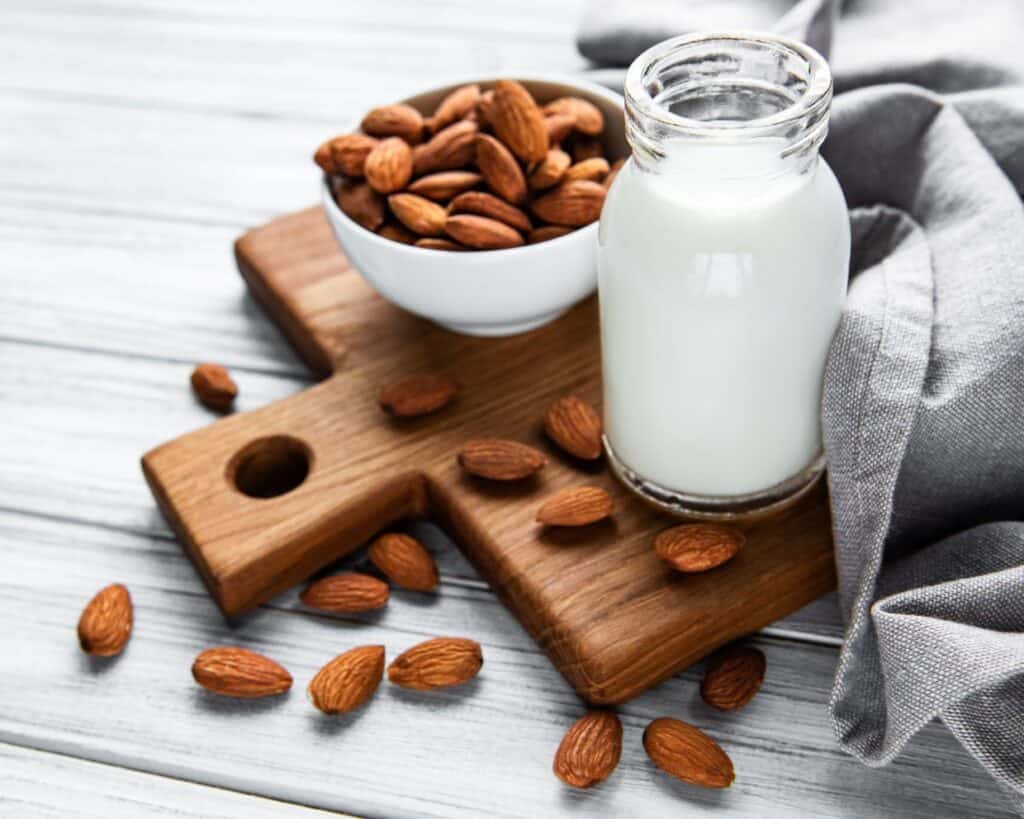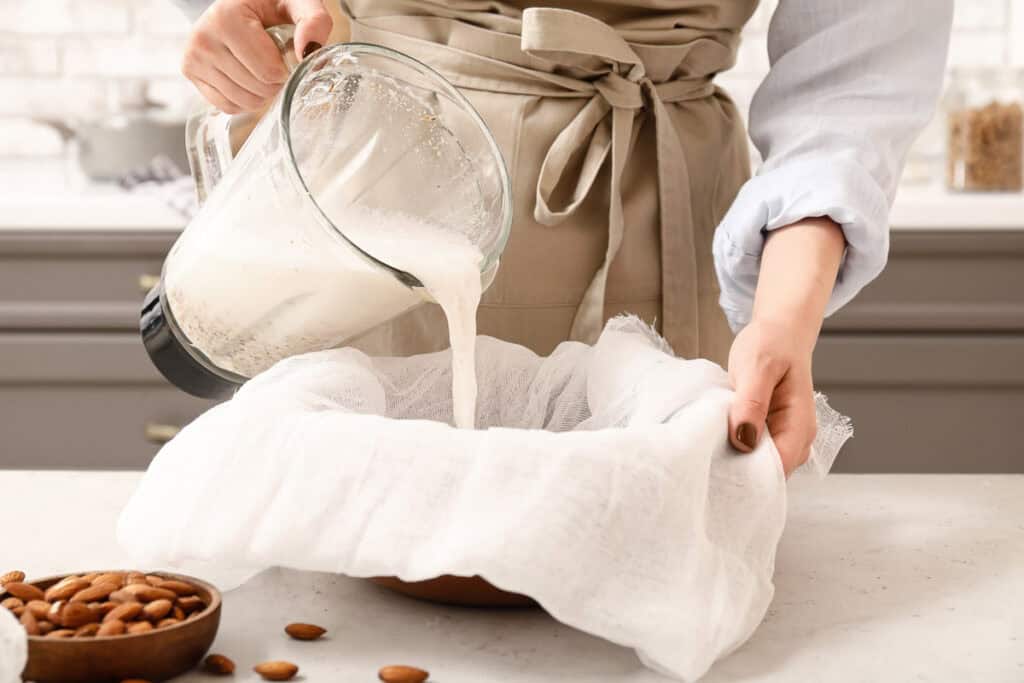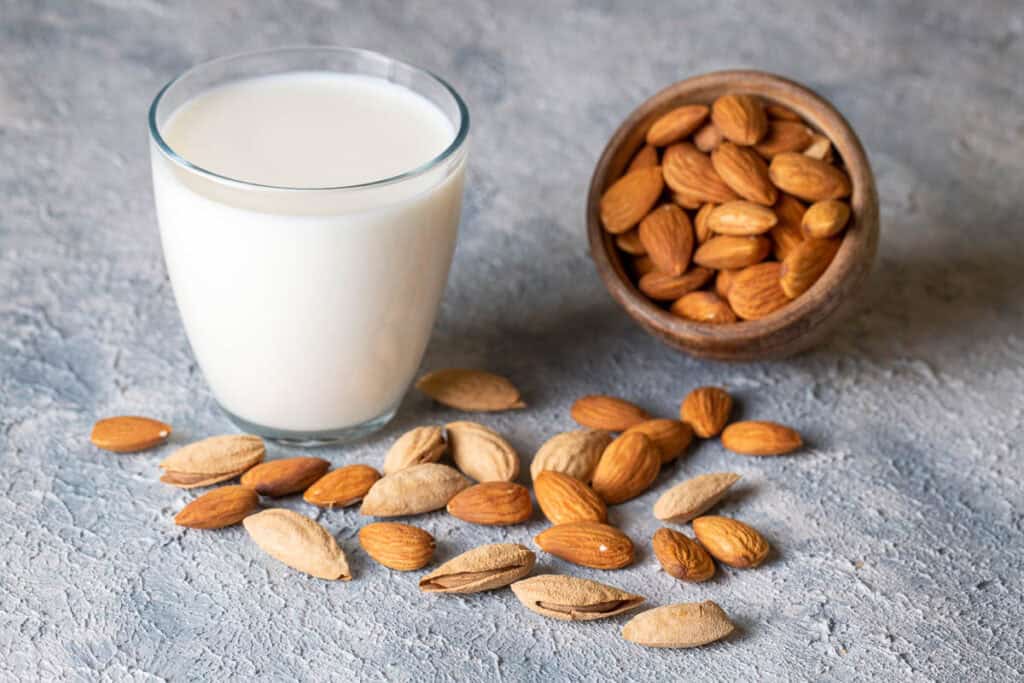After soy, almond milk is one of the OG dairy-free milks and one of the most universally available options in today’s society. Brands like Silk and Almond Breeze brought this nut milk to popularity, and just a few years later, the varieties, brands and options are seemingly endless. If you’re wondering why almond milk rose to fame, how it compares to other options and even how to make your own, read on for our full run-down.

This post may contain affiliate link(s). As an Amazon Associate, I earn from qualifying purchases. See Disclosures.
Almond milk basics
Almond milk benefits many dietary needs and is lactose-free, gluten-free, soy-free and vegan. It’s the perfect solution for anyone looking for an alternative to dairy and is considered one of the more popular plant-based milk options available today.
Commercially sold almond milk typically comes in either unsweetened or sweetened varieties. Some brands also offer flavored almond milk options, such as vanilla.
Nutrition
An 8-ounce serving of unsweetened almond milk contains one of the lowest calorie counts within the alternative milk market at just 40 calories, according to Healthline. It’s also free of added sugar, dietary cholesterol and saturated fat. Besides calories, protein is the most significant difference when comparing almond milk to cow’s milk. An 8-ounce glass of unsweetened almond milk contains 2 grams of protein, whereas the same-sized serving of cow’s milk contains 8 grams.
It’s important to note that almond milk nutrition facts will vary from brand to brand, depending on how finely the almond milk is strained and what additives each company uses. Some brands will add calcium, vitamin D and other nutrients to boost the nutritional profile. Others add emulsifiers and gums to enhance the texture and mouthfeel of the milk. You’ll find brands with a two-ingredient list on one end of the spectrum and others with lists that take up half of the carton on the other. If you’re concerned about ingredient quality, make sure to read the nutrition labels carefully and try out a few brands to find the right almond milk for you.

How almond milk is made
Just like oat milk, making almond milk is a simple process of blending almonds and water together. The mixture is then strained to create an alternative milk-like beverage that many people who experience lactose intolerance or dairy allergies enjoy and appreciate.
The commercial process for making almond milk is broken down into a few stages:
- Almond selection
- Cleaning and soaking
- Grinding and milling
- Filtration and homogenization
- Pasteurization and sterilization
At home, however, the process of making almond milk is a bit more simplistic. Use of a high-powered blender is necessary, but beyond that, the process only involves three easy steps:
- Soaking
- Blending
- Straining
A good starting ratio is one cup of almonds to two cups of water. Once strained, the consistency will be similar to 2% dairy milk. If you like thinner milk, simply increase the amount of water you use when blending. Because there are no preservatives added when you make it yourself, homemade almond milk will only keep for three to five days in the refrigerator.
Small conveniences such as a nut-milk bag make straining much easier than using cheesecloth. If you plan to take on this DIY kitchen project, it’s a worthwhile purchase.
Homemade almond milk also allows for the unique ability to customize flavors and add-ins to your preferences beyond the store-bought options. Extracts, syrups, fruit, cocoa powder and sweeteners can all make for a really delicious homemade almond milk drink.

The best ways to use almond milk
Beyond its use in your morning coffee or a glass accompanying your favorite chocolate chip cookie recipe, you can use almond milk in cooking and baking just like regular cow’s milk. Furthermore, the leftover almond pulp has a variety of uses, from crackers to muffins and lots more.
“We use original almond milk as well as
vanilla -flavored almond milk for our cereal, in our coffee and tea and for baking. I find it easier to digest than oat milk, and it gives a lovely nutty flavor to muffins, pancakes and quickbreads.”— Sarita Harbour, Recipes From Leftovers
Almond milk won’t be a great substitution for ingredients like heavy cream or whole milk as it’s just not as decadently creamy. It’s better to use options like coconut cream or oat milk for any indulgent soups or ice cream recipes. However, almond milk works wonders in dairy-free quick breads, cookies and muffin recipes as well as smoothies, lattes and sauces.
The bottom line
Almond milk has effortlessly become a staple in many households thanks to its versatility and health benefits. Whether you buy it from the store or make it at home, this plant-based alternative offers a convenient and customizable option for anyone avoiding dairy who wants a universally available option wherever they go.
Gina Matsoukas is the writer, photographer and recipe creator of Running to the Kitchen. Focusing on healthy, seasonal, whole-food recipes, her work has been featured in various online and print publications including Food Network, Prevention Magazine and Women’s Health. Gina lives in central New York, where she enjoys an active outdoor life.